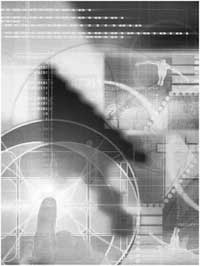 Creative Commons is a nonprofit
Creative Commons is a nonprofit
that offers a flexible copyright for creative work. Creative Commons
defines the spectrum of possibilities between full copyright – all
rights reserved – and the public domain – no rights reserved. Their
licenses help you keep your copyright while inviting certain uses of
your work Рa “some rights reserved” copyright. Extensive
information about their licenses and their legal concepts can be found
here. Soon they will
launch their Science
Commons project which they describe as :
The mission of
Science Commons is to encourage scientific innovation by making it
easier for scientists, universities, and industries to use literature,
data, and other scientific intellectual property and to share their
knowledge with others. Science Commons works within current copyright
and patent law to promote legal and technical mechanisms that remove
barriers to sharing.
Meanwhile, NeverEndingBooks.org
has taken a Attribution-
NonCommercial-NoDerivs 2.0 Belgium license. Here is what it
means

Attribution. You must give the original author credit.
That is, if you use any results contained in the texts offered by
TheLibrary you must give a reference containing the following
information
Author of the text, Title of the work, TheLibrary
(2005) NeverEndingBooks.org
as you would do (I hope) with any
other source you use in your work.

Noncommercial. You may not use this work for commercial
purposes. That is, you are not allowed to copy a text from TheLibrary
and distribute it for money nor may you use any part of this site
(including logos and names) for your own profit. Still, these
restrictions may be waived by the copyright holder(s). This means, in
the case of courses and books from TheLibrary, the author of the text.
For all other matters email copyright@neverendingbooks.org.
 No Derivative Works. You may not alter, transform,
No Derivative Works. You may not alter, transform,
or build upon this work. This means that you are not allowed to copy
texts from TheLibrary, make some modifications or additions to them and
pass them off as your own work. Clearly, you are still allowed to make
‚Äòfair use’ of the material. That is, you can build upon results
contained in the texts assuming you give proper reference (see
above).
Finally, the Belgium-part of the license means that the
legal code of the license (which is available in
Dutch and in
French) works under Belgian law, see here for more
details.
As stated, this is the default (fairly restrictive)
cc-license for NeverEndingBooks. In the future it may be that certain
authors allow access to their texts under other licenses. This will then
be specified by the appropriate icons (see here for other possible
licenses, among which certainly the Developing
Nations license deserves to be promoted). The licenses are also
readable to robots visisting this site and in the near future we will
also include the xmp-metadata
into all available pdf-files.

